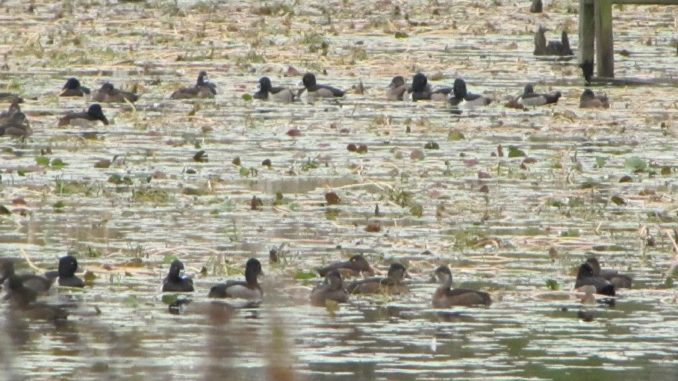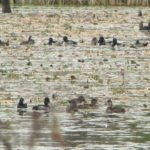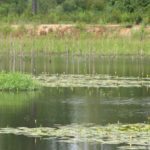
Vegetation provides great menu for waterfowl
It’s never too early to think about ways to attract waterfowl for the 2013 fall season. In fact, March is the optimum time to establish a cost-effective waterfowl forage called the banana water lily — Nymphaea mexicana — especially on those permanently flooded **sites where traditional upland planting is not possible. This plant’s benefits to both waterfowl and landowner outweigh all other forage options as a low-cost, low-maintenance and a highly productive food source for waterfowl.
Native to Florida, banana water lily offers landowners a scenic background for their ponds and an extremely prolific forage factory that ducks will just love. Unlike most foods available for waterfowl, the banana water lily produces a wide variety of forage opportunities from the seeds, the fruit and the young plants to the banana-shaped tubers dangling below the water’s surface.
Beyond the plant itself, the water lily serves as a host to an entire ecosystem of invertebrates that ducks will remember well enough to come back year after year for more. Snails, dragonfly nymphs, crawfish, small clams and many other tiny creatures thrive in the tangled web of banana water lily.
Once established, no maintenance, replanting, fertilizing or liming will ever be required. In fact, no fertilizing or liming is required before planting, either.
Typically, food plots and waterfowl impoundments will follow a strict regimen of herbicides, soil testing, soil amendments, cultivation, constant depredation measures and then more of the same. But it is usually worth the effort when flocks of ducks pour into a flooded field filled with sweet grains full of energy. Banana water lily may be the answer to many duck hunters’ dreams.
It is just the perfect plant to establish on waterfowl ponds, but, there are a few key requirements for this species to prosper, and Jim Hills of Frost Waterfowl is an expert on the plant.
“Banana water lily is truly one of the finest waterfowl foods that exist for a totally flooded ecosystem,” he said. “But, it takes a unique situation to get this plant established.”
For nearly 20 years, Hills has worked with banana water lily, establishing and propagating these plants all over the United States and in several foreign countries for the benefit of waterfowl. According to Hills (843-546-9104), ducks will provide benefits to the plants as much as the plants will benefit the ducks.
“Birds will fertilize it (by defecating) the whole time they are spending time in there,” he said. “It’s a symbiotic relationship.”
Hills prefers sites with full sun, soft, muddy bottoms and water depths between 1 1/2 and four feet.
“The plant will pick a depth it likes the most, but it will thrive at relatively shallow depths,” he said. “It does some exploiting in areas with trees, but not nearly as well as full sun.”
Landowners with low-lying areas flooded for most of the year and void of a significant tree canopy are preferred. Since the south is covered with beaver ponds, these areas may offer a good solution when prolonged flooding has removed the tree component. Typically, beaver ponds will have soft bottoms, too, that helps pushing the tubers into the soil.
The shallow end of ponds, lakes and borrow pits could provide ideal conditions for this plant. Ponds and lakes with established fish populations will benefit from banana water lily, as long as a strong population of the herbivorous grass carp is not present. The lilies will have difficulties overcoming the aggressive feeding of these fish. Carp learn to love this plant as soon as it shows up; in fact, they will consume the plant with a vengeance until all of the plants are destroyed. While carp are a wonderful addition to ponds with weed problems, banana water lily will have a tough row to hoe when carp are plentiful. Choose ponds lacking significant populations of grass carp, including the triploid variety, in order to get water lily started.
In addition to carp depredation, newly-planted banana water lily will struggle in ponds with a dense coverage of existing aquatic vegetation. Hills recommends treating these areas with herbicides during the fall before planting to allow the lily time to grow and propagate. After the plants get fully established, the large green pads will shade out many of the other species that would normally grow in these areas.
Since banana water lily is an aquatic plant, drying and periods of droughty conditions are not good for the plant, either. Sites where the shallows won’t dry out should be chosen. Hills (www.frostwaterfowl.com) said plants will survive if drained for brief durations. “If the water lily seed and tubers dry out completely, dust dry, they will die. The soils need to remain moist.”
For best results, planting season begins in February and continues through April. Hills said that success diminishes as planting is extended into late spring and summer.
Landowners establish banana water lily through seeding the plants themselves or pushing the tubers into the mud. Planting rates range from 500 plants per acre to get the pond started to 1,750 plants per acre for complete coverage ready for a fall hunt the next duck season.
Banana water lily will attract a wide variety of ducks depending on the water level. Historically, water lily was once known to provide mostly food for diving ducks such as canvasback, blue bill, ring neck and northern shoveler, but puddle ducks, such as widgeon, teal, wood ducks, pintails, gadwall, and mallard will enjoy the buffet this prolific plant can offer too.
“When we lowered the water level in our ponds to 12 to 18 inches during duck season, the amount of ducks using our ponds increased by 50 percent. The lower water level allowed puddle ducks to take advantage of the nutritious food source,” he said. “We recommend that banana water lily be managed at a lower water level in the winter if maximum waterfowl usage is desired.”






Be the first to comment